
Creative Problem Solving
Copyright: 2013, James Robert Watson, PhD. Illustrations by Mitch Baker
How to be a better creative problem solver
Here's the most important thing you can do: You must want to do it. Your growth as a more creative problem solver comes from within, in response to your repeated and sincere desire to solve problems more creatively. That's first and foremost.
Understanding the process and practicing a few exercises can help open your mind to:
• get great ideas easier
• creatively solve problems
• take more risks
• be more courageous
• be less fearful
• have more fluid thinking
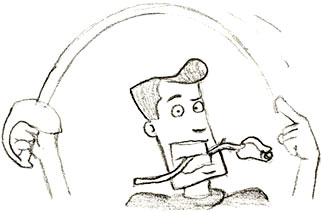
To succeed, you must have both of these - Passion and Courage. You need a deep-rooted desire to live, love, and breathe that which you feel strongly about.
But passion is useless without the courage to do something about it.
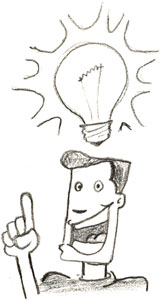
Getting the great idea
The 'Ah Ha! Eureka' moment is a great feeling. Getting a new thought that resolves something or solves a problem. Some itch or some connection. Its fun to get great ideas. Sometimes frustrating, sometimes elusive. But always part of the joy of human existence, the essence of life and living. It makes us feel alive when we solve problems, make connections, and see in new ways - experience the "I've got it" moment. It’s what our minds exist to do. It makes us feel young and active. The mind is working and alive. The mind kicks into gear and goes to work sending messages to the conscious front.
Becoming a better problem solver and creative thinker is a lifelong process. Be patient, work at it sincerely. Some people will experience immediate responses to the exercises and changes in attitude. For some others, it may not feel like you're getting anywhere, until you get there. Unlike activities with immediate response and satisfaction.
Getting great ideas and solutions is easy. Understanding the process and practicing a few basic principles can allow anyone to be more innovative, open-minded, and a more creative problem solver.
Some definitions
An idea is a new thought: specifically a combination of previously unrelated thoughts that create a new concept or direction. All these thoughts were in the mind. They just needed to be put into new arrangements. A creative idea is often based on pattern recognition. “That looks somewhat like that which reminds me of that.” That thought, perception, or image then becomes memory and can form the basis for later pattern recognition. An idea is the stimulating sensation of a mental event. Its an entity with its own character and personality. There are 2 main types of ideas:
A creative thought can be defined as pure thought: thinking without constraint or thinking without fear. The natural state of the human mind is to think creatively. Humans are compulsive creators.
Requirements for CPS
All healthy humans are capable of solving problems. Problem solving ability is inherent in the human mind. The brain loves to solve problems: just let it. It will solve any and every problem you give it provided it can meet these 4 conditions:
The brain must know the target to shoot for, the goal, to stay on track, to assess efforts.
Understand the problem. The more you know, the easier it is to obtain a solution. Usually, if a barrier is met during the problem solving process it is due to a lack of information or not understanding the information. See the problem as others may see it. Do more research, talk to people, use the product or item. Problem solvers become authorities on the problem and its ramifications. Creative people are well read.
The mind will find it tough to complete the process if it does not see a personal benefit,: personal growth, meeting a challenge, money, grade, respect, etc.
The mind knows what it must do but it needs to know by when. If a deadline is not set, the mind will prioritize and probably work on other more important projects.
Information processing
Human thought (perception, acceptance, processing, and storage) is the specific interaction of chemicals and electricity inside the mysterious organ called the brain. These interactions occur between brain cell relay stations called neurons. Each neuron receives a chemical message through receivers (dendrites) and sends a signal through its tail (axon) and across a gap (synapse) to a neighboring dendrite receiver.
The brain contains 10-100 billion neurons (who could count?) Each forms bridges to so many other neurons that the brain is abuzz with as many as 1 quadrillion connections (about the number of stars in the known universe). Information processing is an active process. The mind is deciding what to focus on, what to ignore, what is information, what is junk, what to remember, etc. Information is gathered, sorted, interpreted, and remembered.
The human brain is divided into two hemispheres. Each side has specific capabilities and functions to perform although the other side could perform a function if necessary. Both sides are used, to varying degrees, in most thinking functions.

The left side is more logical, verbal, linear, sequential, temporal, serious, mathematical, orderly, and rational.
The right side is more artistic, nonverbal, here and now, spatial, positive, meditative, flexible, creative, spontaneous, and imaginative.
In many Americans, the left side of the brain is more dominant, often as a result of societal conditioning.
The optimal brain is one in which both sides are well developed: a balanced brain. If you are right brain dominant try to develop your left hemisphere and vice versa.
Connecting the two hemispheres is a bundle of 200 million nerve fibers called the corpus callosum. As you read this sentence your corpus callosum is carrying 4 billion impulses a second from one side of your active brain to the other.
The donut wall
All messages to your brain pass through your personal belief system. These values are influenced by your health, ethnicity, genetics, environment, parents, friends, expectations, goals, and desires. These mental perceptions affect the processing and outcome of your thoughts. We often hold our beliefs too close. Let them go. Avoid becoming a fanatic to your values. We get too hung up on right and wrong, with no grey area. We defend our beliefs and attack those who may question them. Remove the layers that inhibit, cover, and hide our free thoughts. Becoming a better creative problem solver requires courage, risks. The mind is infinitely creative, it knows no bounds. The boundaries are perceptions we use to establish comfort and security, to defend and attack. Let go.
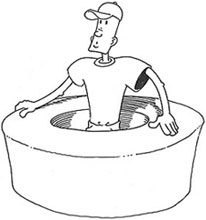
We build barriers, like a ring wall around us.
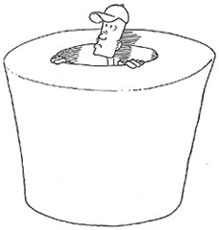
Sometimes its tall and thick. It provides a comfortable secure guard against adversity, and protects us (so we think) from things we fear. We feel we need it to feel safe and secure when facing threatening frightening world. But world is not threatening, only our perceptions of it. If we change our perceptions of it, we can remove the cloak, walk free and open.
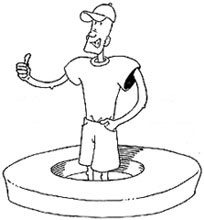
Work at lowering the wall, making it thinner. Step over it. Let other people in, over it. Be about the mind. Affect attitudes, not control them.
Experience life with open palms, not clenched fists.
Many people lose their ability to solve problems and think creatively because they've allowed or developed blocks and barriers in their minds which stifle creative thought. The greatest barriers to creative thought are usually built by some form of fear. To become a better creative problem solver, acknowledge your fears. Affirm that they can control you, then let them go. Replace them with positive affirmations.
Don't try to be more creative. Try to be less inhibited and more creative thoughts will happen. Creative thoughts cannot be forced, only fostered. You can, however, force a stimulus to creative thought. Do something to break the block: read, doodle, talk, sing, dance, blow bubbles, laugh, skip, take risks; just do something.
Have the courage to fail. It is better to fail while taking a risk than to succeed while playing it safe. Great problem solvers have the courage to fight for what they believe. They stand up for their beliefs and solutions.
Strive for an open mind. This is the most important goal a growing problem solvers can strive for. An open mind allows greater input of information; greater retrieval of information; and better tolerance of ideas, values, and people different from us.
Great problem solvers are well rounded and well read people. They are active in cultural enrichment activities. They constantly strive to experience new sources of enlightening input to stretch limits, broaden horizons, make new connections, and see in new ways. This allows them to better enhance their creative output and increase the wealth of resources from which to draw inspiration and influence.
When you stretch your mind, it never returns to its original shape.
Problem solvers are learners. They know that the responsibility of learning and growing is theirs alone. Because creative thought is a personal courage of the mind, creative people often stand apart from society and in conflict with it. But it is this courage to be yourself in the fullest sense that allows you to grow into the person you are capable of becoming.